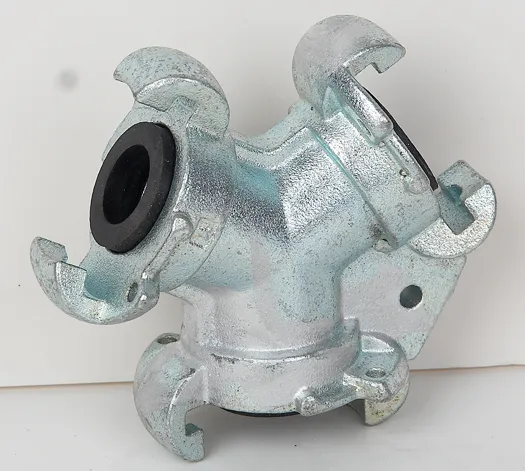Choosing and Maintaining Your Australian Type Universal Claw Coupling Type A
2024-11-08
The Australian Type Universal Claw Coupling Type A is known for its reliability and durability, but like any piece of equipment, it needs proper selection and maintenance to perform optimally. In this post, we’ll share some practical tips for choosing the right claw coupling and maintaining it to extend its lifespan and ensure a safe, efficient connection.
How to Choose the Right Australian Type Universal Claw Coupling Type A
Selecting the appropriate claw coupling is crucial for ensuring compatibility, safety, and durability. Here are some factors to consider:
1. Material Selection: Type A claw couplings are available in various materials, such as cast iron, stainless steel, and brass.
- Cast Iron: Known for its strength and durability, cast iron is often chosen for heavy-duty applications but can be prone to rust if not maintained.
- Stainless Steel: Resistant to corrosion and ideal for marine or highly humid environments, stainless steel is more expensive but provides excellent longevity.
- Brass: Ideal for applications where corrosion resistance is essential, especially when dealing with water lines or mildly corrosive environments.
2. Gasket Material: The gasket within the coupling is essential for creating a tight seal. Common gasket materials include:
- Nitrile (NBR): Suitable for general-purpose use, especially with water and air, and offers good resistance to oils.
- Viton: A more durable option for high-temperature or chemical applications.
- EPDM: Ideal for applications involving hot water or steam but not suitable for oil-based substances.
3. Size and Compatibility: Ensure the coupling size matches the hose size for a secure fit. Universal compatibility means that these couplings can often be interchanged, but verifying the connection diameter is still important for maximum safety.
4. Working Pressure: The coupling’s working pressure rating should match or exceed the pressure requirements of your application. Overloading a coupling beyond its pressure capacity can lead to premature wear or even dangerous blowouts.
5. Operating Environment: Consider the environmental factors, such as temperature, humidity, and exposure to chemicals. Choosing the right material for your specific conditions can prevent premature wear and extend the coupling’s life.
Maintenance Tips for Australian Type Universal Claw Coupling Type A
Proper maintenance ensures the longevity and reliability of your claw coupling. Here are some maintenance practices to keep in mind:
1. Regular Inspections: Periodically inspect the coupling for any signs of wear, damage, or corrosion. Look closely at the claw sections, gasket, and fasteners, as these areas are most susceptible to wear.
2. Cleaning: Dirt, dust, and debris can accumulate on the coupling over time, particularly in outdoor or industrial settings. Clean the coupling with water or a mild cleaner and wipe it dry to prevent corrosion or build-up that can affect the coupling’s performance.
3. Check and Replace Gaskets: The gasket plays a key role in creating a leak-proof seal. If you notice any cracks, hardening, or deformation in the gasket, replace it immediately to prevent leaks and maintain performance.
4. Lubricate the Claws: Light lubrication on the claws can help them operate smoothly and reduce wear. Be cautious not to over-lubricate, as excess grease can attract dirt and debris, leading to build-up.
5. Monitor for Corrosion: If the coupling is used in a humid or marine environment, keep an eye out for signs of corrosion, especially with cast iron models. Applying a corrosion-resistant coating or choosing a more corrosion-resistant material (like stainless steel) can mitigate this issue.
6. Avoid Over-Tightening: Claw couplings are designed for tool-free connection, and over-tightening can damage the claws or gasket. Tighten only as needed for a secure, leak-proof fit.
Common Problems and Solutions
1. Leakage: If you’re experiencing leaks, check the gasket and ensure it’s seated properly. Replacing a worn or deformed gasket typically resolves leakage issues.
2. Difficulty in Connection: When claw couplings are hard to connect, it may be due to wear or misalignment. Cleaning the claws and applying a light lubricant can ease the connection.
3. Rust or Corrosion: In humid or outdoor environments, rust can be an issue for cast iron couplings. Regular cleaning and applying a rust-preventive spray can extend the lifespan of your coupling.
4. Wear on the Claws: Over time, the claw sections can wear down, leading to a weaker connection. Inspect the claws regularly and replace the coupling if the claws show excessive wear.
Best Practices for Safe and Efficient Use
1. Check Pressure Ratings: Always ensure that the pressure ratings of the coupling match your application. Exceeding the pressure limit can lead to dangerous malfunctions.
2. Standardize Coupling Sizes: Using the same size and type of claw coupling throughout your equipment reduces compatibility issues and ensures seamless operation.
3. Use Compatible Hose Ends: The compatibility between the hose ends and the coupling is essential for a secure fit and optimal performance.
The Australian Type Universal Claw Coupling Type A is a versatile, reliable choice for industrial, construction, and agricultural applications. By choosing the right material, size, and gasket, and maintaining the coupling properly, you can ensure that it performs reliably in even the most demanding environments. With regular care, these couplings can provide years of service, making them an excellent investment for your equipment.



